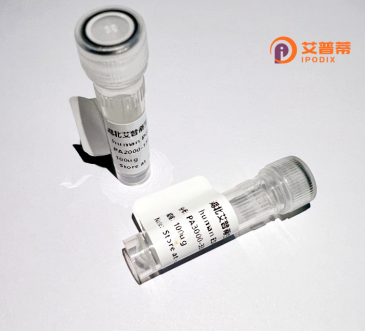
| 纯度 | >90%SDS-PAGE. |
| 种属 | Human |
| 靶点 | POLD3 |
| Uniprot No | Q15054 |
| 内毒素 | < 0.01EU/μg |
| 表达宿主 | E.coli |
| 表达区间 | 2-466 aa |
| 活性数据 | ADQLYLENI DEFVTDQNKI VTYKWLSYTL GVHVNQAKQM LYDYVERKRK ENSGAQLHVT YLVSGSLIQN GHSCHKVAVV REDKLEAVKS KLAVTASIHV YSIQKAMLKD SGPLFNTDYD ILKSNLQNCS KFSAIQCAAA VPRAPAESSS SSKKFEQSHL HMSSETQANN ELTTNGHGPP ASKQVSQQPK GIMGMFASKA AAKTQETNKE TKTEAKEVTN ASAAGNKAPG KGNMMSNFFG KAAMNKFKVN LDSEQAVKEE KIVEQPTVSV TEPKLATPAG LKKSSKKAEP VKVLQKEKKR GKRVALSDDE TKETENMRKK RRRIKLPESD SSEDEVFPDS PGAYEAESPS PPPPPSPPLE PVPKTEPEPP SVKSSSGENK RKRKRVLKSK TYLDGEGCIV TEKVYESESC TDSEEELNMK TSSVHRPPAM TVKKEPREER KGPKKGTAAL GKANRQVSIT GFFQRK |
| 分子量 | 51.4 kDa |
| 蛋白标签 | His tag N-Terminus |
| 缓冲液 | PBS, pH7.4, containing 0.01% SKL, 1mM DTT, 5% Trehalose and Proclin300. |
| 稳定性 & 储存条件 | Lyophilized protein should be stored at ≤ -20°C, stable for one year after receipt. Reconstituted protein solution can be stored at 2-8°C for 2-7 days. Aliquots of reconstituted samples are stable at ≤ -20°C for 3 months. |
| 复溶 | Always centrifuge tubes before opening.Do not mix by vortex or pipetting. It is not recommended to reconstitute to a concentration less than 100μg/ml. Dissolve the lyophilized protein in distilled water. Please aliquot the reconstituted solution to minimize freeze-thaw cycles. |
以下是关于重组人POLD3蛋白的3篇参考文献概述:
---
1. **文献名称**:*POLδ subunit POLD3 regulates embryonic development and genomic stability in mice*
**作者**:Li et al.
**摘要**:该研究利用基因敲除小鼠模型,发现POLD3缺失会导致胚胎致死性发育缺陷,并增加DNA复制压力下的基因组不稳定性,证明POLD3在维持DNA复制保真性和胚胎发育中的关键作用。
2. **文献名称**:*POLD3 promotes homologous recombination-mediated DNA repair in mammalian cells*
**作者**:Huang et al.
**摘要**:作者通过CRISPR筛选和生化实验,发现POLD3通过与RAD51和BRCA1相互作用,促进同源重组修复(HR)效率,尤其在复制叉重启和双链断裂修复中具有重要功能,为癌症治疗靶点研究提供依据。
3. **文献名称**:*Structural insights into the role of POLD3 in the DNA polymerase δ complex*
**作者**:Zhang et al.
**摘要**:该研究通过冷冻电镜解析了人源DNA聚合酶δ(包含POLD3亚基)的三维结构,揭示了POLD3在稳定聚合酶活性中心和协调其他亚基(如POLD1/POLD2)构象变化中的分子机制。
---
提示:若需具体文献,建议通过PubMed或Google Scholar检索关键词“POLD3”、“DNA polymerase delta subunit 3”获取全文。
DNA polymerase delta subunit 3 (POLD3), also known as polymerase delta-interacting protein 3. is a critical component of the DNA polymerase delta complex in humans. This multifunctional enzyme plays essential roles in DNA replication and repair processes, particularly in lagging-strand synthesis, translesion synthesis, and break-induced replication. Encoded by the POLD3 gene on chromosome 16. the 466-amino-acid protein contains conserved domains for interaction with other polymerase delta subunits (POLD1. POLD2. and POLD4) and participates in maintaining genomic stability.
Recombinant human POLD3 protein is produced through molecular cloning techniques, typically expressed in E. coli or mammalian cell systems. Its recombinant form enables detailed biochemical studies of DNA synthesis mechanisms, including fidelity regulation and protein-protein interactions within the replication machinery. Research highlights its significance in cancer biology, as POLD3 dysregulation has been linked to tumor progression and chemoresistance through impaired DNA damage response. Recent studies also explore its potential as a therapeutic target, particularly in cancers with DNA repair deficiencies. The development of recombinant POLD3 has advanced structural characterization efforts, revealing key functional motifs that could inform targeted drug design. Current applications span in vitro DNA replication assays, CRISPR-based gene editing optimization, and biomarker discovery for precision oncology.
×